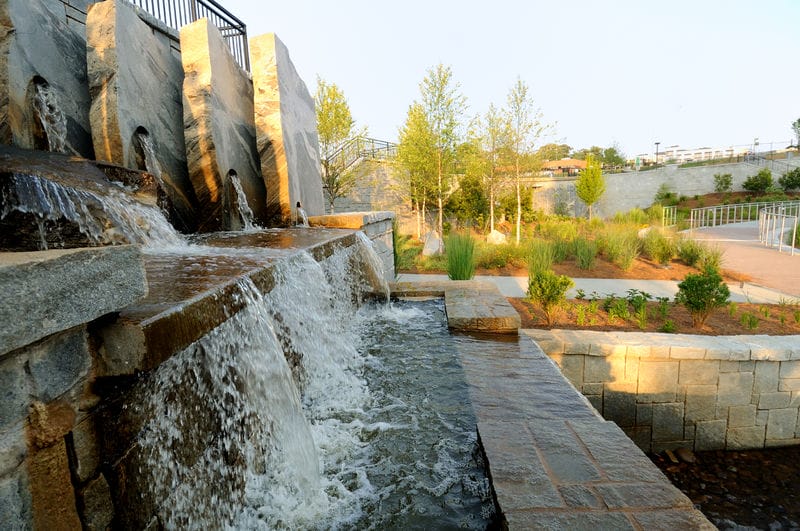When you enjoy the simple pleasures of a park—a shady spot to read or the sight of a duck gliding across a pond—you might not be thinking about what’s going on behind the scenes in the service of climate resilience. But at TPL, we are. When we design and build parks with residents and partners, we incorporate all kinds of climate-smart green infrastructure to improve resilience to heat, floods, and other threats. In doing so, we’re creating a replicable model for park development nationwide. Here are some of our most impactful green spaces — all of which couple function with form in a big way.
Hover over the numbers on the map to read more about each park:
1. Green Alleys
Los Angeles, CA
The Central-Jefferson and Quincy Jones Green Alley networks near South L.A.’s Central Avenue jazz district turned 11 underused alleys into safe, shaded pedestrian routes featuring trees, flowering vines, and colorful murals. They’re also engineered to manage stormwater, capturing more than 1.5 million gallons per year and replenishing underground aquifers that provide water to a region increasingly at risk of drought.
2. Story Mill Community Park
Bozeman, MT
This award-winning park and nature sanctuary—which is home to over 100 species of birds—undid heavy damage from prior industrialization. Now, its 60 acres include a restored riverfront, regenerated wetlands, and natural streams that greatly improve local water quality, plus a community garden to feed residents.
3. Montbello Open Space Park
Denver, CO
Once a trash-strewn vacant lot, this 5.5-acre park, which serves 42,000 nearby residents, is now a restored native shortgrass prairie with an outdoor classroom, walking trails, interactive play spaces, and art designed with local students. It also features a central arroyo that collects and cleans stormwater before releasing it.
4. Five Mile Creek Greenbelt
Dallas, TX
This ambitious greenbelt will include three new TPL parks and a 17-mile trail stretching across southern Dallas, adding vital green space for nearly 200,000 residents who increasingly face record- setting heat. Climate-smart features include native rain gardens and lighting that’s 100 percent solar-powered, which will save $71,000 in electricity costs over the next 20 years.
5. Midway Peace Park
St. Paul, MN
Residents of nearby Skyline Tower once had scant access to green space. Now, the community enjoys a climate-smart park with playing fields, bike paths, two rain gardens, a playground, and features that collect and filter 1.5 million gallons of runoff annually, keeping polluted water from flowing into the Mississippi River.
6. WACA Bell Park
Chicago, IL
Based on ideas sourced from residents, TPL worked with partners to reinvent this once-vibrant park, which serves 9,487 residents within a 10-minute walk. Its transformation includes new trees, which will combat rising temperatures in an urban heat island, permeable surfaces that reduce flooding, and upcoming solar panels that will power lighting and Wi-Fi throughout the park.
7. Rockefeller Park
Cleveland, OH
Once complete, this renovated park—the city’s largest, covering 200 acres—will connect five nearby neighborhoods to the outdoors and to the Cleveland Cultural Gardens, a series of public gardens celebrating the region’s ethnic diversity. A watershed restoration at Doan Brook will also address dangerous stormwater flooding.
8. Dundee Island Park
Passaic, NJ
Previously underused, this park—which serves 20,160 residents within a 10-minute walk—was transformed with local input and now includes a boat launch, soccer field, community garden, and walking trails. And its climate-smart design accommodates Passaic River flooding events, mitigating damage to surrounding neighborhoods.
9. The Pacific School
Brooklyn, NY
This project, which reduces neighborhood flooding and pollution of nearby Gowanus Canal, is among several Community Schoolyards® projects to be completed with New York City’s Extreme Weather Task Force. It’s capable of managing 1.2 million gallons of rainwater a year, enough to cover a football field in 4 feet of water.
10. Historic Fourth Ward Park
Atlanta, GA
Part of the Atlanta BeltLine—a 22-mile green space network— “H4WP,” as it’s known, gives people a place to cool off, play, and enjoy outdoor gatherings—all while providing safety against floods that previously inundated surrounding communities. The park’s infrastructure can decrease peak stormwater flow by as much as 44 million gallons of rainwater per day.
Feeling Inspired?
Join us in our mission to bring climate-smart green spaces to millions of people across America.
Amy McCullough is senior writer and editor for Trust for Public Land and managing editor of Land&People magazine. She is also the author of The Box Wine Sailors, an adventure memoir.

Donate to become a member, and you’ll receive a subscription to Land&People magazine, our biannual publication featuring exclusive, inspiring stories about our work connecting everyone to the outdoors.

